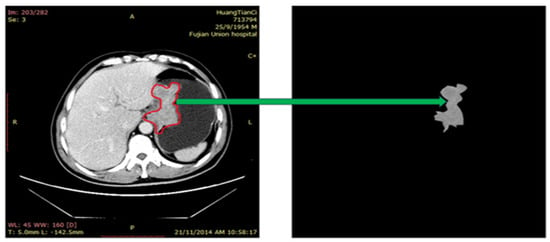-
 NSCLC Digital PCR Panel Returns Low-Input Sample Results Where Sequencing Fails
NSCLC Digital PCR Panel Returns Low-Input Sample Results Where Sequencing Fails -
 Optimizing the Clinical Use of High-Sensitivity Troponin Assays: A Review
Optimizing the Clinical Use of High-Sensitivity Troponin Assays: A Review -
 Contemporary Evidence and Practice on Right Heart Catheterization in Patients with Acute or Chronic Heart Failure
Contemporary Evidence and Practice on Right Heart Catheterization in Patients with Acute or Chronic Heart Failure -
 Autoimmune Hepatitis: A Diagnostic and Therapeutic Overview
Autoimmune Hepatitis: A Diagnostic and Therapeutic Overview -
 Radiographic Imaging for the Diagnosis and Treatment of Patients with Skeletal Class III Malocclusion
Radiographic Imaging for the Diagnosis and Treatment of Patients with Skeletal Class III Malocclusion
Journal Description
Diagnostics
Diagnostics
is an international, peer-reviewed, open access journal on medical diagnosis published semimonthly online by MDPI. The British Neuro-Oncology Society (BNOS), the International Society for Infectious Diseases in Obstetrics and Gynaecology (ISIDOG) and the Swiss Union of Laboratory Medicine (SULM) are affiliated with Diagnostics and their members receive a discount on the article processing charges.
- Open Access— free for readers, with article processing charges (APC) paid by authors or their institutions.
- High Visibility: indexed within Scopus, SCIE (Web of Science), PubMed, PMC, Embase, Inspec, CAPlus / SciFinder, and other databases.
- Journal Rank: JCR - Q2 (Medicine, General & Internal)
- Rapid Publication: manuscripts are peer-reviewed and a first decision is provided to authors approximately 20.7 days after submission; acceptance to publication is undertaken in 2.8 days (median values for papers published in this journal in the second half of 2023).
- Recognition of Reviewers: reviewers who provide timely, thorough peer-review reports receive vouchers entitling them to a discount on the APC of their next publication in any MDPI journal, in appreciation of the work done.
- Companion journal: LabMed.
Impact Factor:
3.6 (2022);
5-Year Impact Factor:
3.7 (2022)
Latest Articles
A Neoteric Feature Extraction Technique to Predict the Survival of Gastric Cancer Patients
Diagnostics 2024, 14(9), 954; https://doi.org/10.3390/diagnostics14090954 (registering DOI) - 01 May 2024
Abstract
Background: At the time of cancer diagnosis, it is crucial to accurately classify malignant gastric tumors and the possibility that patients will survive. Objective: This study aims to investigate the feasibility of identifying and applying a new feature extraction technique to predict the
[...] Read more.
Background: At the time of cancer diagnosis, it is crucial to accurately classify malignant gastric tumors and the possibility that patients will survive. Objective: This study aims to investigate the feasibility of identifying and applying a new feature extraction technique to predict the survival of gastric cancer patients. Methods: A retrospective dataset including the computed tomography (CT) images of 135 patients was assembled. Among them, 68 patients survived longer than three years. Several sets of radiomics features were extracted and were incorporated into a machine learning model, and their classification performance was characterized. To improve the classification performance, we further extracted another 27 texture and roughness parameters with 2484 superficial and spatial features to propose a new feature pool. This new feature set was added into the machine learning model and its performance was analyzed. To determine the best model for our experiment, Random Forest (RF) classifier, Support Vector Machine (SVM), K-Nearest Neighbors (KNN), and Naïve Bayes (NB) (four of the most popular machine learning models) were utilized. The models were trained and tested using the five-fold cross-validation method. Results: Using the area under ROC curve (AUC) as an evaluation index, the model that was generated using the new feature pool yields AUC = 0.98 ± 0.01, which was significantly higher than the models created using the traditional radiomics feature set (p < 0.04). RF classifier performed better than the other machine learning models. Conclusions: This study demonstrated that although radiomics features produced good classification performance, creating new feature sets significantly improved the model performance.
Full article
(This article belongs to the Section Machine Learning and Artificial Intelligence in Diagnostics)
►
Show Figures
Open AccessCase Report
Mucin-Producing Lobular Breast Carcinoma Metastasis to an Ovarian Fibroma: Histopathological and Immunohistochemical Analysis of a Rare Case and Literature Review
by
Alexandra Corina Faur, Camelia Vidiţa Gurban, Ecaterina Dăescu, Răzvan Vlad Tîrziu, Daniela Cornelia Lazăr and Laura Andreea Ghenciu
Diagnostics 2024, 14(9), 953; https://doi.org/10.3390/diagnostics14090953 (registering DOI) - 30 Apr 2024
Abstract
Breast cancer stands as the primary cause of cancer-related mortality among women worldwide, often presenting with distant metastases upon diagnosis. Ovarian metastases originating from breast cancer represent a range of 3–30% of all ovarian neoplasms. Case Report: Herein, we present the histopathological, histochemical,
[...] Read more.
Breast cancer stands as the primary cause of cancer-related mortality among women worldwide, often presenting with distant metastases upon diagnosis. Ovarian metastases originating from breast cancer represent a range of 3–30% of all ovarian neoplasms. Case Report: Herein, we present the histopathological, histochemical, and immunohistochemical findings of a rare case involving mucin-producing lobular breast carcinoma metastasizing to an ovarian fibroma in an 82-year-old female previously diagnosed with lobular breast carcinoma. Histopathological examination of the excised tissues revealed a biphasic neoplasm characterized by tumor cells expressing AE-1/AE-3 cytokeratin, mammaglobin, GCDFP-15, inhibin, and calretinin. Positive mucin staining was observed using histochemical techniques, and reticulin fibers were demonstrated using the Gordon–Sweets technique. A final diagnosis of mucin-producing lobular breast carcinoma metastatic to a benign ovarian fibroma was rendered. Conclusion: The occurrence of metastatic breast carcinoma overlaid on an ovarian tumor represents a rare and diagnostically challenging scenario.
Full article
(This article belongs to the Special Issue Advances in the Diagnosis and Management of Gynecological Oncology)
Open AccessArticle
Deep Learning-Based Classification and Semantic Segmentation of Lung Tuberculosis Lesions in Chest X-ray Images
by
Chih-Ying Ou, I-Yen Chen, Hsuan-Ting Chang, Chuan-Yi Wei, Dian-Yu Li, Yen-Kai Chen and Chuan-Yu Chang
Diagnostics 2024, 14(9), 952; https://doi.org/10.3390/diagnostics14090952 (registering DOI) - 30 Apr 2024
Abstract
We present a deep learning (DL) network-based approach for detecting and semantically segmenting two specific types of tuberculosis (TB) lesions in chest X-ray (CXR) images. In the proposed method, we use a basic U-Net model and its enhanced versions to detect, classify, and
[...] Read more.
We present a deep learning (DL) network-based approach for detecting and semantically segmenting two specific types of tuberculosis (TB) lesions in chest X-ray (CXR) images. In the proposed method, we use a basic U-Net model and its enhanced versions to detect, classify, and segment TB lesions in CXR images. The model architectures used in this study are U-Net, Attention U-Net, U-Net++, Attention U-Net++, and pyramid spatial pooling (PSP) Attention U-Net++, which are optimized and compared based on the test results of each model to find the best parameters. Finally, we use four ensemble approaches which combine the top five models to further improve lesion classification and segmentation results. In the training stage, we use data augmentation and preprocessing methods to increase the number and strength of lesion features in CXR images, respectively. Our dataset consists of 110 training, 14 validation, and 98 test images. The experimental results show that the proposed ensemble model achieves a maximum mean intersection-over-union (MIoU) of 0.70, a mean precision rate of 0.88, a mean recall rate of 0.75, a mean F1-score of 0.81, and an accuracy of 1.0, which are all better than those of only using a single-network model. The proposed method can be used by clinicians as a diagnostic tool assisting in the examination of TB lesions in CXR images.
Full article
(This article belongs to the Special Issue Recent Advances in Artificial Intelligence-Based Medical Image Analysis)
Open AccessArticle
Novel Tools for Single Comparative and Unified Evaluation of Qualitative and Quantitative Bioassays: SS/PV–ROC and SS-J/PV-PSI Index–ROC Curves with Integrated Concentration Distributions, and SS-J/PV-PSI Index Cut-Off Diagrams
by
Peter Oehr
Diagnostics 2024, 14(9), 951; https://doi.org/10.3390/diagnostics14090951 (registering DOI) - 30 Apr 2024
Abstract
Background: This investigation is both a study of potential non-invasive diagnostic approaches for the bladder cancer biomarker UBC® Rapid test and a study including novel comparative methods for bioassay evaluation and comparison that uses bladder cancer as a useful example. The objective
[...] Read more.
Background: This investigation is both a study of potential non-invasive diagnostic approaches for the bladder cancer biomarker UBC® Rapid test and a study including novel comparative methods for bioassay evaluation and comparison that uses bladder cancer as a useful example. The objective of the paper is not to investigate specific data. It is used only for demonstration, partially to compare ROC methodologies and also to show how both sensitivity/specificity and predictive values can be used in clinical diagnostics and decision making. This study includes ROC curves with integrated cut-off distribution curves for a comparison of sensitivity/specificity (SS) and positive/negative predictive values (PPV/NPV or PV), as well as SS-J index/PV-PSI index–ROC curves and SS-J/PV-PSI index cut-off diagrams (J = Youden, PSI = Predictive Summary Index) for the unified direct comparison of SS-J/PV results achieved via quantitative and/or qualitative bioassays and an identification of optimal separate or unified index cut-off points. Patients and Methods: According to the routine diagnostics, there were 91 patients with confirmed bladder cancer and 1152 patients with no evidence of bladder cancer, leading to a prevalence value of 0.073. This study performed a quantitative investigation of used-up test cassettes from the visual UBC® Rapid qualitative point-of-care assay, which had already been applied in routine diagnostics. Using a photometric reader, quantitative data could also be obtained from the test line of the used cassettes. Interrelations between SS and PV values were evaluated using cumulative distribution analysis (CAD), SS/PV–ROC curves, SS-J/PV-PSI index–ROC curves, and the SS-J/PV-PSI index cut-off diagram. The maximum unified SS-J/PV-PSI index value and its corresponding cut-off value were determined and calculated with the SS-J/PV-PSI index cut-off diagram. Results: The use of SS/PV–ROC curves with integrated cut-off concentration distribution curves provides improved diagnostic information compared to “traditional” ROC curves. The threshold distributions integrated as curves into SS/PV–ROC curves and SS-J/PV-PSI index–ROC curves run in opposite directions. In contrast to the SS–ROC curves, the PV–ROC and the novel PV-PSI index–ROC curves had neither an area under the curve (AUC) nor a range from 0% to 100%. The cut-off level of the qualitative assay was 7.5 µg/L, with a sensitivity of 65.9% and a specificity of 63.3%, and the PPV was 12.4% and the NPV was 95.9%, at a threshold value of 12.5 µg/L. Based on these set concentrations, the reader-based evaluation revealed a graphically estimated 5% increase in sensitivity and a 13% increase in specificity, as compared to the visual qualitative POC test. In the case of predictive values, there was a gain of 8% for PPV and 10% for NPV. The index values and cut-offs were as follows: visual SS-J index, 0.328 and 35 µg/L; visual PV-PSI index, 0.083 and 5.4 µg/L; maximal reader Youden index, 0.0558 and 250 µg/L; and maximal PV-PSI index, 0.459 and 250 µg/L, respectively. The maximum unified SS-J/PV-PSI index value was 0.32, and the cut-off was 43 µg/L. The reciprocal SS-J index correctly detected one out of three patients, while the reciprocal PV-PSI index gave one out of twelve patients a correct diagnosis. Conclusions: ROC curves including cut-off distribution curves supplement the information lost in “traditionally plotted” ROC curves. The novel sets of ROC and index–ROC curves and the new SS/PV index cut-off diagrams enable the simultaneous comparison of sensitivity/specificity and predictive value profiles of diagnostic tools and the identification of optimal cut-off values at maximal index values, even in a unifying SS/PV approach. Because the curves within an SS-J/PV-PSI index cut-off diagram are distributed over the complete cut-off range of a quantitative assay, this field is open for special clinical considerations, with the need to vary the mentioned clinical diagnostic parameters. Complete or partial areas over the x-axis (AOX) can be calculated for summarized quantitative or qualitative effectivity evaluations with respect to single and/or unified SS-J and PV-PSI indices and with respect to single, several, or several unified assays. The SS-J/PV-PSI index-AOX approach is a new tool providing additional joint clinical information, and the reciprocal SS-J indices can predict the number of patients with a correct diagnosis and the number of persons who need to be examined in order to correctly predict a diagnosis of the disease. These methods could be used in applications like medical or plant epidemiology, machine learning algorithms, and neural networks.
Full article
(This article belongs to the Section Clinical Laboratory Medicine)
Open AccessReview
Vascular Endothelial Damage in COPD: Where Are We Now, Where Will We Go?
by
Gianluca Screm, Lucrezia Mondini, Francesco Salton, Paola Confalonieri, Liliana Trotta, Mariangela Barbieri, Antonio Romallo, Alessandra Galantino, Michael Hughes, Selene Lerda, Marco Confalonieri and Barbara Ruaro
Diagnostics 2024, 14(9), 950; https://doi.org/10.3390/diagnostics14090950 (registering DOI) - 30 Apr 2024
Abstract
Background: Chronic obstructive pulmonary disease (COPD) has higher rates among the general population, so early identification and prevention is the goal. The mechanisms of COPD development have not been completely established, although it has been demonstrated that endothelial dysfunction plays an important role.
[...] Read more.
Background: Chronic obstructive pulmonary disease (COPD) has higher rates among the general population, so early identification and prevention is the goal. The mechanisms of COPD development have not been completely established, although it has been demonstrated that endothelial dysfunction plays an important role. However, to date, the measurement of endothelial dysfunction is still invasive or not fully established. Nailfold video capillaroscopy (NVC) is a safe, non-invasive diagnostic tool that can be used to easily evaluate the microcirculation and can show any possible endothelial dysfunctions early on. The aim of this review is to evaluate if nailfold microcirculation abnormalities can reflect altered pulmonary vasculature and can predict the risk of cardiovascular comorbidities in COPD patients. Methods: A systematic literature search concerning COPD was performed in electronic databases (PUBMED, UpToDate, Google Scholar, ResearchGate), supplemented with manual research. We searched in these databases for articles published until March 2024. The following search words were searched in the databases in all possible combinations: chronic obstructive pulmonary disease (COPD), endothelial damage, vascular impairment, functional evaluation, capillaroscopy, video capillaroscopy, nailfold video capillaroscopy. Only manuscripts written in English were considered for this review. Papers were included only if they were able to define a relationship between COPD and endothelium dysfunction. Results: The search selected 10 articles, and among these, only three previous reviews were available. Retinal vessel imaging, flow-mediated dilation (FMD), and skin autofluorescence (AF) are reported as the most valuable methods for assessing endothelial dysfunction in COPD patients. Conclusions: It has been assumed that decreased nitric oxide (NO) levels leads to microvascular damage in COPD patients. This finding allows us to assume NVC’s potential effectiveness in COPD patients. However, this potential link is based on assumption; further investigations are needed to confirm this hypothesis.
Full article
(This article belongs to the Special Issue Diagnosis, Classification, and Monitoring of Pulmonary Diseases)
►▼
Show Figures

Graphical abstract
Open AccessReview
Sensitivity and Specificity of Selected Biomarkers and Their Combinations in the Diagnosis of Ovarian Cancer (Review)
by
Aleksandra Englisz, Marta Smycz-Kubańska and Aleksandra Mielczarek-Palacz
Diagnostics 2024, 14(9), 949; https://doi.org/10.3390/diagnostics14090949 (registering DOI) - 30 Apr 2024
Abstract
One of the greatest challenges in modern gynecological oncology is ovarian cancer. Despite the numerous studies currently being conducted, it is still sometimes detected at late clinical stages, where the prognosis is unfavorable. One significant contributing factor is the absence of sensitive and
[...] Read more.
One of the greatest challenges in modern gynecological oncology is ovarian cancer. Despite the numerous studies currently being conducted, it is still sometimes detected at late clinical stages, where the prognosis is unfavorable. One significant contributing factor is the absence of sensitive and specific parameters that could aid in early diagnosis. An ideal screening test, in view of the low incidence of ovarian cancer, should have a sensitivity of greater than 75% and a specificity of at least 99.6%. To enhance sensitivity and specificity, diagnostic panels are being created by combining individual markers. The drive to develop better screening tests for ovarian cancer focuses on modern diagnostic methods based on molecular testing, which in turn aims to find increasingly effective biomarkers. Currently, researchers’ efforts are focused on the search for a complementary parameter to those most commonly used that would satisfactorily enhance the sensitivity and specificity of assays. Several biomarkers, including microRNA molecules, autoantibodies, cDNA, adipocytokines, and galectins, are currently being investigated by researchers. This article reviews recent studies comparing the sensitivity and specificity of selected parameters used alone and in combination to increase detection of ovarian cancer at an early stage.
Full article
(This article belongs to the Special Issue Diagnosis and Management of Gynecological Cancers: Volume 3)
Open AccessReview
Emerging Trends in Left Ventricular Thrombus: A Comprehensive Review of Non-Ischemic and Ischemic Cardiopathies, Including Eosinophilic Myocarditis, Chagas Cardiomyopathy, Amyloidosis, and Innovative Anticoagulant Approaches
by
Benjamin Colle, Fabian Demeure, Julien Higny, Martin Benoit, Jean-Philippe Henry, Isabelle Michaux, Robaye Benoit, Olivier Xhaët, Laurence Gabriel, Antoine Guedes, Dominique Blommaert, Nathalie Dulieu, Yannick Berners, Fabian Wery, Steven Droogmans, Bernard Cosyns and Maria-Luiza Luchian
Diagnostics 2024, 14(9), 948; https://doi.org/10.3390/diagnostics14090948 (registering DOI) - 30 Apr 2024
Abstract
This comprehensive review explores the intricate aspects of left ventricular thrombus (LVT), a potential complication in both ischemic and non-ischemic cardiomyopathies. It provides a thorough understanding of left ventricular thrombus, revealing its uncommon incidence in the general population (7 cases per 10,000 patients),
[...] Read more.
This comprehensive review explores the intricate aspects of left ventricular thrombus (LVT), a potential complication in both ischemic and non-ischemic cardiomyopathies. It provides a thorough understanding of left ventricular thrombus, revealing its uncommon incidence in the general population (7 cases per 10,000 patients), predominantly linked to ischemic heart diseases (ICMs) at an 80% prevalence rate. Diagnostic tools, notably transthoracic echocardiography (TTE) and cardiac magnetic resonance imaging (CMR), demonstrate varying sensitivity but remain indispensable in specific clinical contexts related to LVT as non-invasive diagnostic modalities. A detailed comparison between ICM patients and those with non-ischemic cardiomyopathy (NICM) who have left ventricular thrombus reveals subtle distinctions with significant clinical implications. This analysis underscores the importance of these imaging techniques in distinguishing between the two conditions. Additionally, we explored the occurrence of LVT in specific non-ischemic cardiomyopathies, including Takotsubo syndrome, hypertrophic cardiomyopathy, eosinophilic myocarditis, Chagas disease, cardiac amyloidosis, and several other conditions. The article further delves into anticoagulation strategies, thoroughly examining their impact on LVT regression and patient outcomes. Pharmacological interventions, with a focus on direct oral anticoagulants, emerge as promising alternatives; however, there is insufficient information on their efficiency and safety, especially in NICM population. In conclusion, this review highlights the complex nature of LVT, incorporating a range of etiopathogenic factors, diagnostic complexities, and evolving therapeutic approaches. It emphasizes the pressing need for ongoing research in this field.
Full article
(This article belongs to the Special Issue New Progress in Diagnosis and Management of Cardiovascular Diseases)
►▼
Show Figures

Figure 1
Open AccessArticle
Urinary Epidermal Growth Factor Level as a Noninvasive Indicator of Tubular Repair in Patients with Acute Kidney Injury
by
Kazutoshi Ono, Akito Maeshima, Izumi Nagayama, Taro Kubo, Takashi Yagisawa and Daisuke Nagata
Diagnostics 2024, 14(9), 947; https://doi.org/10.3390/diagnostics14090947 (registering DOI) - 30 Apr 2024
Abstract
Epidermal growth factor (EGF), an essential factor for the proliferation and survival of renal tubular cells, is expressed by distal tubules and normally excreted via urine. Previous studies in rats demonstrated that acute tubular injury reduces urinary EGF levels. However, it is unclear
[...] Read more.
Epidermal growth factor (EGF), an essential factor for the proliferation and survival of renal tubular cells, is expressed by distal tubules and normally excreted via urine. Previous studies in rats demonstrated that acute tubular injury reduces urinary EGF levels. However, it is unclear whether urinary EGF is a suitable monitoring marker of tubular repair status after acute kidney injury (AKI) in humans. To address this question, we measured serum and urinary EGF in patients with AKI (n = 99) using ELISA and investigated whether urinary EGF levels were associated with the severity of tubular injury and renal prognosis. Urinary EGF was abundant in healthy controls but showed a significant decrease in AKI patients (14,522 ± 2190 pg/mL vs. 3201 ± 459.7 pg/mL, p < 0.05). The urinary EGF level in patients with renal AKI was notably lower than that in patients with pre-renal AKI. Furthermore, the urinary EGF level in patients with AKI stage 3 was significantly lower than that in patients with AKI stage 1. Urinary EGF levels were negatively correlated with urinary β-2MG and serum creatinine levels but positively correlated with hemoglobin levels and eGFR. Urinary EGF was not significantly correlated with urinary NAG, α-1MG, L-FABP, NGAL, KIM-1, or urinary protein concentrations. No significant correlation was observed between serum and urinary EGF levels, suggesting that urinary EGF is derived from the renal tubules rather than the blood. In living renal transplantation donors, the urinary EGF/Cr ratio was approximately half the preoperative urinary EGF/Cr ratio after unilateral nephrectomy. Collectively, these data suggest that urinary EGF is a suitable noninvasive indicator of not only the volume of functional normal renal tubules but also the status of tubular repair after AKI.
Full article
(This article belongs to the Special Issue Kidney Disease: Biomarkers, Diagnosis, and Prognosis: 2nd Edition)
Open AccessArticle
Long-Term Effects of 0.1 mg Recombinant-Human-Thyrotropin-Stimulated Fixed-Dose Radioiodine Therapy in Patients with Recurrent Multinodular Goiter after Surgery
by
Nicholas Angelopoulos, Ioannis Iakovou, Grigoris Effraimidis and Sarantis Livadas
Diagnostics 2024, 14(9), 946; https://doi.org/10.3390/diagnostics14090946 (registering DOI) - 30 Apr 2024
Abstract
(1) Background: After thyroid malignancy is ruled out, treatment options for multinodular goiter patients include surgery, levothyroxine suppressive therapy, and 131-I therapy. Surgery effectively reduces goiter size but carries risks of surgical and anesthetic complications. 131-I therapy is the only nonsurgical alternative, but
[...] Read more.
(1) Background: After thyroid malignancy is ruled out, treatment options for multinodular goiter patients include surgery, levothyroxine suppressive therapy, and 131-I therapy. Surgery effectively reduces goiter size but carries risks of surgical and anesthetic complications. 131-I therapy is the only nonsurgical alternative, but its effectiveness diminishes with goiter size and depends on iodine sufficiency. This study aimed to assess the efficacy and safety of 0.1 mg rhTSH as an adjuvant to a fixed dose of 131-I therapy in patients with a recurrence of large multinodular goiter, several years after the initial thyroidectomy. (2) Methods: 14 patients (13 females and 1 male), aged 59.14 ± 15.44 (range, 35–78 years) received 11mciu of 131-I, 24 h after the administration of 0.1 mg rhTSH. The primary endpoint was the change in thyroid volume (by ultrasound measurements) as well as in the diameter of the predominant nodule during a follow-up period of 10 years. Secondary endpoints were the alterations in thyroid function and potential adverse effects. (3) Results: A significant decrease in the volume of initial thyroid remnants (32.16 ± 16.66 mL) was observed from the first reevaluation (at 4 months, 23.12 ± 11.59 mL) as well as at the end of the follow-up period (10 years, 12.62 ± 8.76 mL), p < 0.01. A significant reduction in the dominant nodule was also observed (from 31.71 ± 10.46 mm in the beginning to 26.67 ± 11.05 mm). (4) Conclusions: Further investigation is needed since this approach could be attractive in terms of minimizing the potential risks of reoperation in these patients.
Full article
(This article belongs to the Section Clinical Laboratory Medicine)
►▼
Show Figures
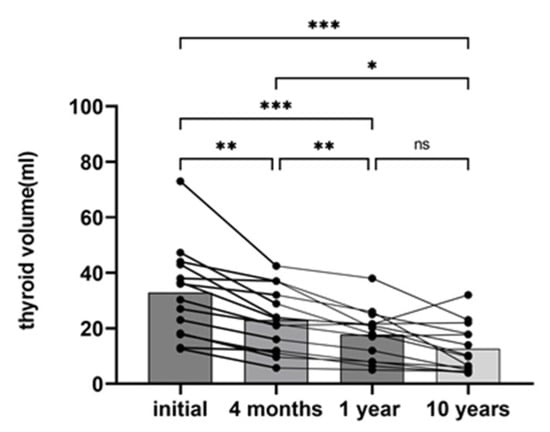
Figure 1
Open AccessArticle
Hair Evaluation in Orthodontic Patients with Oligodontia
by
Małgorzata Zadurska, Adriana Rakowska, Ewa Czochrowska, Małgorzata Laskowska, Konrad Perkowski, Izabela Strużycka, Lidia Rudnicka and Agnieszka Jurek
Diagnostics 2024, 14(9), 945; https://doi.org/10.3390/diagnostics14090945 (registering DOI) - 30 Apr 2024
Abstract
Oligodontia can be isolated or syndromic, associated with other ectodermal abnormalities. The aim of the study was to perform hair examination in orthodontic patients diagnosed with oligodontia with a low clinical expression of symptoms of ectodermal origin. All available orthodontic patients diagnosed with
[...] Read more.
Oligodontia can be isolated or syndromic, associated with other ectodermal abnormalities. The aim of the study was to perform hair examination in orthodontic patients diagnosed with oligodontia with a low clinical expression of symptoms of ectodermal origin. All available orthodontic patients diagnosed with oligodontia in the permanent dentition were enrolled. Hair examination included clinical evaluation of the patients’ hair, trichoscopy, trichogram and evaluation of the hair shafts under a polarized light microscope. In total, 25 patients, 18 males and 7 females, aged 6 to 24 years were evaluated for the presence of dental and hair abnormalities. The number of congenitally absent teeth ranged from 6 to 24 teeth and diastemas, microdontia, taurodontism and altered tooth shape were found in 23 patients. Hair disorders were found in 68% of the subjects. Hypotrichosis, the heterogeneity of shaft color and loss of pigment, androgenetic alopecia, telogen effluvium, trichoschisis, pili canaliculi, trichorrhexis nodosa and pseudomoniletrix were observed. Trichoscopy and trichogram are valid non-invasive diagnostic tests which could be used to differentiate between isolated and syndromic oligodontia in patients with a low clinical expression of ectodermal symptoms.
Full article
(This article belongs to the Special Issue New Insights into Diagnosis of Orthodontics)
Open AccessArticle
Radiomic Features of Acute Cerebral Hemorrhage on Non-Contrast CT Associated with Patient Survival
by
Saif Zaman, Fiona Dierksen, Avery Knapp, Stefan P. Haider, Gaby Abou Karam, Adnan I. Qureshi, Guido J. Falcone, Kevin N. Sheth and Seyedmehdi Payabvash
Diagnostics 2024, 14(9), 944; https://doi.org/10.3390/diagnostics14090944 (registering DOI) - 30 Apr 2024
Abstract
The mortality rate of acute intracerebral hemorrhage (ICH) can reach up to 40%. Although the radiomics of ICH have been linked to hematoma expansion and outcomes, no research to date has explored their correlation with mortality. In this study, we determined the admission
[...] Read more.
The mortality rate of acute intracerebral hemorrhage (ICH) can reach up to 40%. Although the radiomics of ICH have been linked to hematoma expansion and outcomes, no research to date has explored their correlation with mortality. In this study, we determined the admission non-contrast head CT radiomic correlates of survival in supratentorial ICH, using the Antihypertensive Treatment of Acute Cerebral Hemorrhage II (ATACH-II) trial dataset. We extracted 107 original radiomic features from n = 871 admission non-contrast head CT scans. The Cox Proportional Hazards model, Kaplan–Meier Analysis, and logistic regression were used to analyze survival. In our analysis, the “first-order energy” radiomics feature, a metric that quantifies the sum of squared voxel intensities within a region of interest in medical images, emerged as an independent predictor of higher mortality risk (Hazard Ratio of 1.64, p < 0.0001), alongside age, National Institutes of Health Stroke Scale (NIHSS), and baseline International Normalized Ratio (INR). Using a Receiver Operating Characteristic (ROC) analysis, “the first-order energy” was a predictor of mortality at 1-week, 1-month, and 3-month post-ICH (all p < 0.0001), with Area Under the Curves (AUC) of >0.67. Our findings highlight the potential role of admission CT radiomics in predicting ICH survival, specifically, a higher “first-order energy” or very bright hematomas are associated with worse survival outcomes.
Full article
(This article belongs to the Special Issue Advances in Cerebrovascular Imaging and Interventions)
►▼
Show Figures
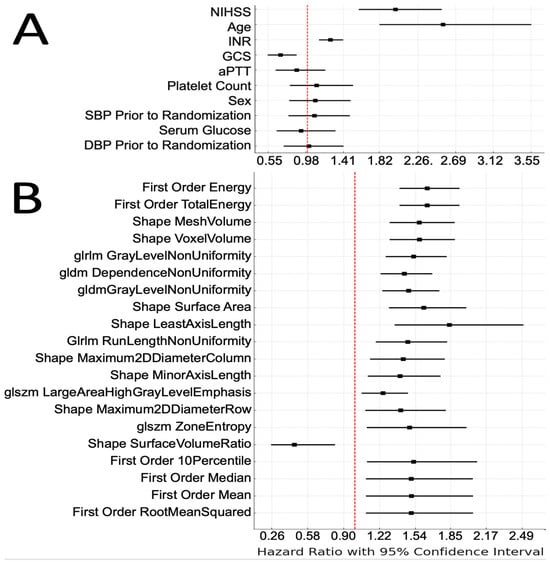
Figure 1
Open AccessArticle
Case Ascertainment of Measles during a Large Outbreak—Laboratory Compared to Epidemiological Confirmation
by
Chen Stein-Zamir, Nitza Abramson, Irina Sokolov, Lia Mor-Shimshi and Hanna Shoob
Diagnostics 2024, 14(9), 943; https://doi.org/10.3390/diagnostics14090943 (registering DOI) - 30 Apr 2024
Abstract
Measles is a highly contagious viral disease, and hence, sufficient herd immunity is obligatory to prevent infection transmission. Measles is still a cause of considerable disease burden globally, mainly in children. During a national measles outbreak in Israel in 2018–2019, the peak incidence
[...] Read more.
Measles is a highly contagious viral disease, and hence, sufficient herd immunity is obligatory to prevent infection transmission. Measles is still a cause of considerable disease burden globally, mainly in children. During a national measles outbreak in Israel in 2018–2019, the peak incidence rates occurred in the Jerusalem district. Most measles cases in the Jerusalem district (75.5%, 1702) were observed in children younger than 15 years of age, 49.2% (1109) were in children under 5 years of age, and 18.9% (425) were in infants under 1 year of age. The routine measles vaccination schedule includes two doses at 1 and 6 years of age. Most cases (1828, 81.1%) were unvaccinated (zero measles vaccine doses). These cases comprised the 425 affected infants under 1 year of age, who were ineligible for vaccination, along with the 1403 children over 1 year of age, who were otherwise unvaccinated. This study aimed to describe the epidemiologic and laboratory features of this measles outbreak, and to investigate case ascertainment (laboratory confirmed compared to epidemiologically confirmed cases). The study population included 2254 measles cases notified during the period spanning June 2018 to May 2019 in the Jerusalem district (incidence rate 176 per 10,000 population). Of the 2254 cases, 716 (31.8%) were laboratory confirmed, and 1538 (68.2%) were confirmed as epidemiologically linked. Most laboratory confirmed cases (420, 58.7%) underwent real-time PCR tests. Serological tests (measles IgM and IgG) were used in 189 (26.4%) cases, and a combination of RT-PCR and serology was used in 107 (14.9%) cases. In a multivariate model analysis, the variables significantly associated (after adjustment) with higher odds for laboratory confirmation included month of disease onset (late), additional measles cases in the household (single case), place of medical treatment (hospital; either emergency department, or hospitalization) and vaccination status (at least one prior vaccine dose). The measles outbreak described demonstrates the urgency of addressing vaccination gaps with appropriate outbreak prevention programs. The road to measles elimination needs to be paved with robust public health infrastructure, excellent field epidemiology for outbreak surveillance, investigation, and control, and laboratory proficiency.
Full article
(This article belongs to the Special Issue Laboratory Diagnosis of Infectious Diseases)
►▼
Show Figures
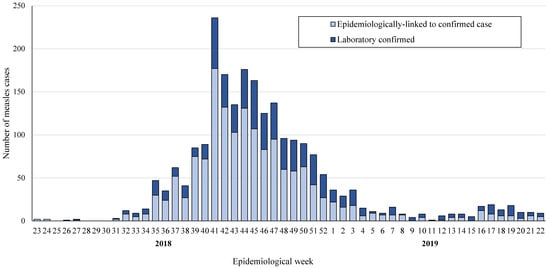
Figure 1
Open AccessArticle
Intraoperative Ultrasound: Bridging the Gap between Laparoscopy and Surgical Precision during 3D Laparoscopic Partial Nephrectomies
by
Ionela Mihai, Horatiu Dura, Cosmin Adrian Teodoru, Samuel Bogdan Todor, Cristian Ichim, Nicolae Grigore, Cosmin Ioan Mohor, Alin Mihetiu, George Oprinca, Nicolae Bacalbasa, Denisa Tanasescu, Dan Georgian Bratu, Adrian Boicean, Bogdan Oros and Adrian Hasegan
Diagnostics 2024, 14(9), 942; https://doi.org/10.3390/diagnostics14090942 (registering DOI) - 30 Apr 2024
Abstract
The use of 3D laparoscopic partial nephrectomy has emerged as a cornerstone in the surgical arsenal for addressing renal tumors, particularly in managing challenging cases characterized by deeply seated tumors embedded within the renal parenchyma. In these intricate scenarios, the utilization of intraoperative
[...] Read more.
The use of 3D laparoscopic partial nephrectomy has emerged as a cornerstone in the surgical arsenal for addressing renal tumors, particularly in managing challenging cases characterized by deeply seated tumors embedded within the renal parenchyma. In these intricate scenarios, the utilization of intraoperative ultrasound (IOUS) acquires paramount importance, serving as an indispensable tool for guiding and meticulously monitoring the surgical process in real time. To further explore the efficacy of IOUS-guided techniques, we conducted a retrospective study comparing outcomes in patients who underwent partial nephrectomy with IOUS guidance (n = 60) between 2020 and 2022 with a cohort from 2018 to 2019 without IOUS guidance (n = 25). Our comprehensive analysis encompassed various post-operative parameters, including the duration until food resumption, analgesia requirements, and length of the hospital stay. While these parameters exhibited comparable outcomes between the two groups, notable distinctions emerged in the intraoperative metrics. The IOUS-guided cohort demonstrated significantly reduced blood loss, a shorter median operative duration, and diminished ischemia time (p = 0.001). These compelling findings underscore the undeniable benefits of IOUS-guided techniques in not only facilitating the attainment of negative surgical margins but also in enhancing procedural safety and precision, thereby contributing to improved patient outcomes in the management of renal tumors.
Full article
(This article belongs to the Section Medical Imaging and Theranostics)
►▼
Show Figures

Figure 1
Open AccessArticle
Utility of CT Radiomics and Delta Radiomics for Survival Evaluation in Locally Advanced Nasopharyngeal Carcinoma with Concurrent Chemoradiotherapy
by
Yen-Cho Huang, Shih-Ming Huang, Jih-Hsiang Yeh, Tung-Chieh Chang, Din-Li Tsan, Chien-Yu Lin and Shu-Ju Tu
Diagnostics 2024, 14(9), 941; https://doi.org/10.3390/diagnostics14090941 (registering DOI) - 30 Apr 2024
Abstract
Background: A high incidence rate of nasopharyngeal carcinoma (NPC) has been observed in Southeast Asia compared to other parts of the world. Radiomics is a computational tool to predict outcomes and may be used as a prognostic biomarker for advanced NPC treated with
[...] Read more.
Background: A high incidence rate of nasopharyngeal carcinoma (NPC) has been observed in Southeast Asia compared to other parts of the world. Radiomics is a computational tool to predict outcomes and may be used as a prognostic biomarker for advanced NPC treated with concurrent chemoradiotherapy. Recently, radiomic analysis of the peripheral tumor microenvironment (TME), which is the region surrounding the gross tumor volume (GTV), has shown prognostic usefulness. In this study, not only was gross tumor volume (GTVt) analyzed but also tumor peripheral regions (GTVp) were explored in terms of the TME concept. Both radiomic features and delta radiomic features were analyzed using CT images acquired in a routine radiotherapy process. Methods: A total of 50 patients with NPC stages III, IVA, and IVB were enrolled between September 2004 and February 2014. Survival models were built using Cox regression with clinical factors (i.e., gender, age, overall stage, T stage, N stage, and treatment dose) and radiomic features. Radiomic features were extracted from GTVt and GTVp. GTVp was created surrounding GTVt for TME consideration. Furthermore, delta radiomics, which is the longitudinal change in quantitative radiomic features, was utilized for analysis. Finally, C-index values were computed using leave-one-out cross-validation (LOOCV) to evaluate the performances of all prognosis models. Results: Models were built for three different clinical outcomes, including overall survival (OS), local recurrence-free survival (LRFS), and progression-free survival (PFS). The range of the C-index in clinical factor models was (0.622, 0.729). All radiomics models, including delta radiomics models, were in the range of (0.718, 0.872). Among delta radiomics models, GTVt and GTVp were in the range of (0.833, 0.872) and (0.799, 0.834), respectively. Conclusions: Radiomic analysis on the proximal region surrounding the gross tumor volume of advanced NPC patients for survival outcome evaluation was investigated, and preliminary positive results were obtained. Radiomic models and delta radiomic models demonstrated performance that was either superior to or comparable with that of conventional clinical models.
Full article
(This article belongs to the Special Issue Applications of CT Scans to Quantitative Imaging and Precision Medicine)
►▼
Show Figures

Figure 1
Open AccessArticle
Inferior Frontal Sulcal Hyperintensities on Brain MRI Are Associated with Amyloid Positivity beyond Age—Results from the Multicentre Observational DELCODE Study
by
Marc Dörner, Katharina Seebach, Michael T. Heneka, Inga Menze, Roland von Känel, Sebastian Euler, Frank Schreiber, Philipp Arndt, Katja Neumann, Annkatrin Hildebrand, Anna-Charlotte John, Anthony Tyndall, Johannes Kirchebner, Pawel Tacik, Robin Jansen, Alexander Grimm, Solveig Henneicke, Valentina Perosa, Sven G. Meuth, Oliver Peters, Julian Hellmann-Regen, Lukas Preis, Josef Priller, Eike Jakob Spruth, Anja Schneider, Klaus Fliessbach, Jens Wiltfang, Frank Jessen, Ayda Rostamzadeh, Wenzel Glanz, Jan Ben Schulze, Sarah Lavinia Florence Schiebler, Katharina Buerger, Daniel Janowitz, Robert Perneczky, Boris-Stephan Rauchmann, Stefan Teipel, Ingo Kilimann, Christoph Laske, Matthias H. Munk, Annika Spottke, Nina Roy-Kluth, Michael Wagner, Ingo Frommann, Falk Lüsebrink, Peter Dechent, Stefan Hetzer, Klaus Scheffler, Luca Kleineidam, Melina Stark, Matthias Schmid, Ersin Ersözlü, Frederic Brosseron, Michael Ewers, Björn H. Schott, Emrah Düzel, Gabriel Ziegler, Hendrik Mattern, Stefanie Schreiber and Jose Bernaladd
Show full author list
remove
Hide full author list
Diagnostics 2024, 14(9), 940; https://doi.org/10.3390/diagnostics14090940 (registering DOI) - 30 Apr 2024
Abstract
Inferior frontal sulcal hyperintensities (IFSHs) on fluid-attenuated inversion recovery (FLAIR) sequences have been proposed to be indicative of glymphatic dysfunction. Replication studies in large and diverse samples are nonetheless needed to confirm them as an imaging biomarker. We investigated whether IFSHs were tied
[...] Read more.
Inferior frontal sulcal hyperintensities (IFSHs) on fluid-attenuated inversion recovery (FLAIR) sequences have been proposed to be indicative of glymphatic dysfunction. Replication studies in large and diverse samples are nonetheless needed to confirm them as an imaging biomarker. We investigated whether IFSHs were tied to Alzheimer’s disease (AD) pathology and cognitive performance. We used data from 361 participants along the AD continuum, who were enrolled in the multicentre DELCODE study. The IFSHs were rated visually based on FLAIR magnetic resonance imaging. We performed ordinal regression to examine the relationship between the IFSHs and cerebrospinal fluid-derived amyloid positivity and tau positivity (Aβ42/40 ratio ≤ 0.08; pTau181 ≥ 73.65 pg/mL) and linear regression to examine the relationship between cognitive performance (i.e., Mini-Mental State Examination and global cognitive and domain-specific performance) and the IFSHs. We controlled the models for age, sex, years of education, and history of hypertension. The IFSH scores were higher in those participants with amyloid positivity (OR: 1.95, 95% CI: 1.05–3.59) but not tau positivity (OR: 1.12, 95% CI: 0.57–2.18). The IFSH scores were higher in older participants (OR: 1.05, 95% CI: 1.00–1.10) and lower in males compared to females (OR: 0.44, 95% CI: 0.26–0.76). We did not find sufficient evidence linking the IFSH scores with cognitive performance after correcting for demographics and AD biomarker positivity. IFSHs may reflect the aberrant accumulation of amyloid β beyond age.
Full article
(This article belongs to the Special Issue Advanced Neuroimaging Approaches for Brain Lesion)
►▼
Show Figures
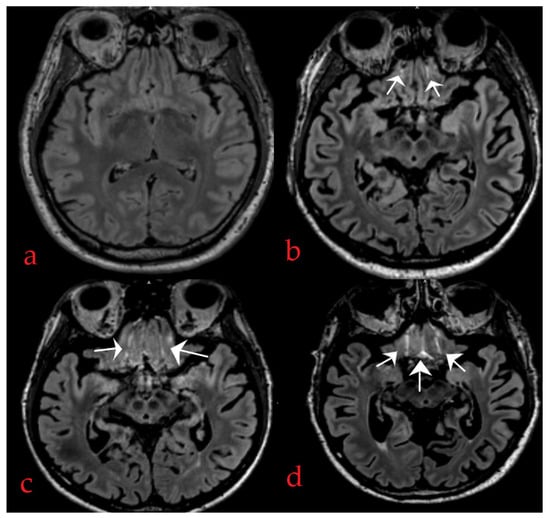
Figure 1
Open AccessReview
The Integration of Deep Learning in Radiotherapy: Exploring Challenges, Opportunities, and Future Directions through an Umbrella Review
by
Andrea Lastrucci, Yannick Wandael, Renzo Ricci, Giovanni Maccioni and Daniele Giansanti
Diagnostics 2024, 14(9), 939; https://doi.org/10.3390/diagnostics14090939 (registering DOI) - 30 Apr 2024
Abstract
This study investigates, through a narrative review, the transformative impact of deep learning (DL) in the field of radiotherapy, particularly in light of the accelerated developments prompted by the COVID-19 pandemic. The proposed approach was based on an umbrella review following a standard
[...] Read more.
This study investigates, through a narrative review, the transformative impact of deep learning (DL) in the field of radiotherapy, particularly in light of the accelerated developments prompted by the COVID-19 pandemic. The proposed approach was based on an umbrella review following a standard narrative checklist and a qualification process. The selection process identified 19 systematic review studies. Through an analysis of current research, the study highlights the revolutionary potential of DL algorithms in optimizing treatment planning, image analysis, and patient outcome prediction in radiotherapy. It underscores the necessity of further exploration into specific research areas to unlock the full capabilities of DL technology. Moreover, the study emphasizes the intricate interplay between digital radiology and radiotherapy, revealing how advancements in one field can significantly influence the other. This interdependence is crucial for addressing complex challenges and advancing the integration of cutting-edge technologies into clinical practice. Collaborative efforts among researchers, clinicians, and regulatory bodies are deemed essential to effectively navigate the evolving landscape of DL in radiotherapy. By fostering interdisciplinary collaborations and conducting thorough investigations, stakeholders can fully leverage the transformative power of DL to enhance patient care and refine therapeutic strategies. Ultimately, this promises to usher in a new era of personalized and optimized radiotherapy treatment for improved patient outcomes.
Full article
(This article belongs to the Special Issue Artificial Intelligence in Clinical Medical Imaging: Volume 2)
►▼
Show Figures
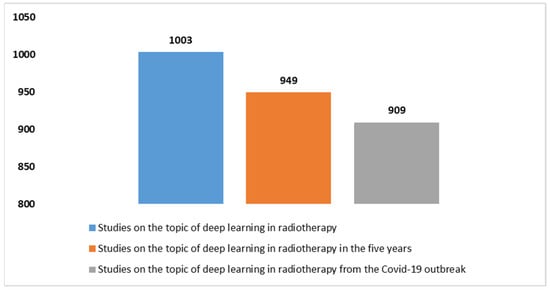
Figure 1
Open AccessReview
Seeing and Sensing the Hepatorenal Syndrome (HRS): The Growing Role of Ultrasound-Based Techniques as Non-Invasive Tools for the Diagnosis of HRS
by
Cornelia Tăluță, Horia Ștefănescu and Dana Crișan
Diagnostics 2024, 14(9), 938; https://doi.org/10.3390/diagnostics14090938 (registering DOI) - 30 Apr 2024
Abstract
More than half of patients hospitalized with liver cirrhosis are dealing with an episode of acute kidney injury; the most severe pattern is hepatorenal syndrome due to its negative prognosis. The main physiopathology mechanisms involve renal vasoconstriction and systemic inflammation. During the last
[...] Read more.
More than half of patients hospitalized with liver cirrhosis are dealing with an episode of acute kidney injury; the most severe pattern is hepatorenal syndrome due to its negative prognosis. The main physiopathology mechanisms involve renal vasoconstriction and systemic inflammation. During the last decade, the definition of hepatorenal syndrome changed, but the validated criteria of diagnosis are still based on the serum creatinine level, which is a biomarker with multiple limitations. This is the reason why novel serum and urinary biomarkers have been intensively studied in recent years. Meanwhile, the imaging studies that use shear wave elastography are using renal stiffness as a surrogate for an early diagnosis. In this article, we focus on the physiopathology definition and highlight the novel tools used in the diagnosis of hepatorenal syndrome.
Full article
(This article belongs to the Special Issue Diagnostic Imaging of Liver Diseases)
►▼
Show Figures
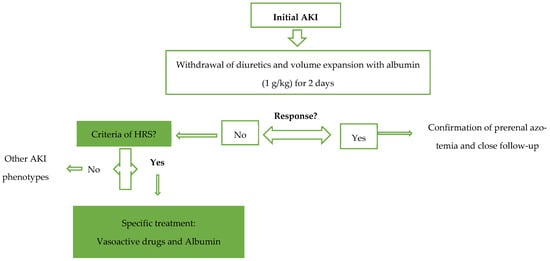
Figure 1
Open AccessReview
Concepts of Cardiac Dyssynchrony and Dynamic Approach
by
Bianca Iulia Catrina, Florina Batar, Ioan Manitiu, Liliana Prodan, Ciprian Tanasescu and Teodora Filip
Diagnostics 2024, 14(9), 937; https://doi.org/10.3390/diagnostics14090937 (registering DOI) - 30 Apr 2024
Abstract
Cardiac conduction involves electrical activity from one myocyte to another, creating coordinated contractions in each. Disruptions in the conducting system, such as left bundle branch block (LBBB), can result in premature activation of specific regions of the heart, leading to heart failure and
[...] Read more.
Cardiac conduction involves electrical activity from one myocyte to another, creating coordinated contractions in each. Disruptions in the conducting system, such as left bundle branch block (LBBB), can result in premature activation of specific regions of the heart, leading to heart failure and increased morbidity and mortality. Structural alterations in T-tubules and the sarcoplasmic reticulum can lead to dyssynchrony, a condition that can be treated by cardiac resynchronization therapy (CRT), which stands as a cornerstone in this pathology. The heterogeneity in patient responses underscored the necessity of improving the diagnostic approach. Vectocardiography, ultra-high-frequency ECG, 3D echocardiography, and electrocardiographic imaging seem to offer advanced precision in identifying optimal candidates for CRT in addition to the classic diagnostic methods. The advent of His bundle pacing and left bundle branch pacing further refined the approach in the treatment of dyssynchrony, offering more physiological pacing modalities that promise enhanced outcomes by maintaining or restoring the natural sequence of ventricular activation. HOT-CRT emerges as a pivotal innovation combining the benefits of CRT with the precision of His bundle or left bundle branch area pacing to optimize cardiac function in a subset of patients where traditional CRT might fall short.
Full article
(This article belongs to the Special Issue Advances in Diagnosis and Treatment of Cardiac Arrhythmias)
►▼
Show Figures
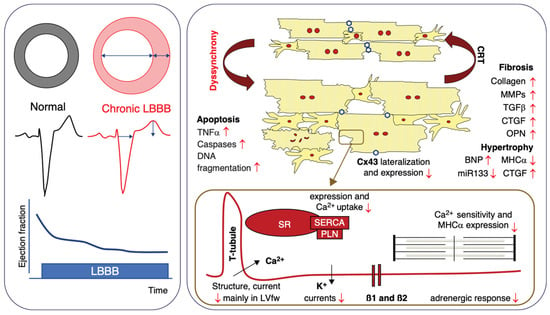
Figure 1
Open AccessCase Report
Electrochemotherapy in Spine Metastases: A Case Series Focused on Technical Aspects, Surgical Strategies and Results
by
Andrea Angelini, Alberto D’Amico, Stefania Paolilli, Riccardo Signori, Giovanni Baldin, Giuseppe Di Rubbo, Luca Denaro and Pietro Ruggieri
Diagnostics 2024, 14(9), 936; https://doi.org/10.3390/diagnostics14090936 (registering DOI) - 30 Apr 2024
Abstract
Metastases are complications of primary tumors due to prolonged cancer survival and have become an important issue for oncological patients and the most frequent cause of death and disability. Bone metastases occur at a later stage of cancer disease, and the spine is
[...] Read more.
Metastases are complications of primary tumors due to prolonged cancer survival and have become an important issue for oncological patients and the most frequent cause of death and disability. Bone metastases occur at a later stage of cancer disease, and the spine is the most frequent site. To date, the aim of the treatment of metastases remains to be the control of disease and provide a satisfactory quality of life. The decision making of treatment is influenced by several factors such as the status of the primary disease, the number of metastases, site involvement, and the performance status of the patients. For this reason, the treatment of metastases is challenging and undergoes constant development. Therefore, alternative techniques with respect to surgery, which is the first option but not always practicable, and radiochemotherapy are attractive. Lately, electrochemotherapy has emerged as an innovative method for treating various primary and metastatic solid tumors, showing promising outcomes in terms of inducing tumor tissue necrosis and alleviating symptoms. This technique uses electric pulses to increase the uptake of chemotherapy by tumor cells. Despite the initial enthusiasm and good results in the treatment of bone tumors, relatively few papers have described its use in spine metastases. Therefore, we conducted a systemic review of this intriguing topic while also reporting our experience in the use of electrochemotherapy for the treatment of spine metastases.
Full article
(This article belongs to the Special Issue Diagnosis of Spinal Tumors: 3rd Edition)
►▼
Show Figures
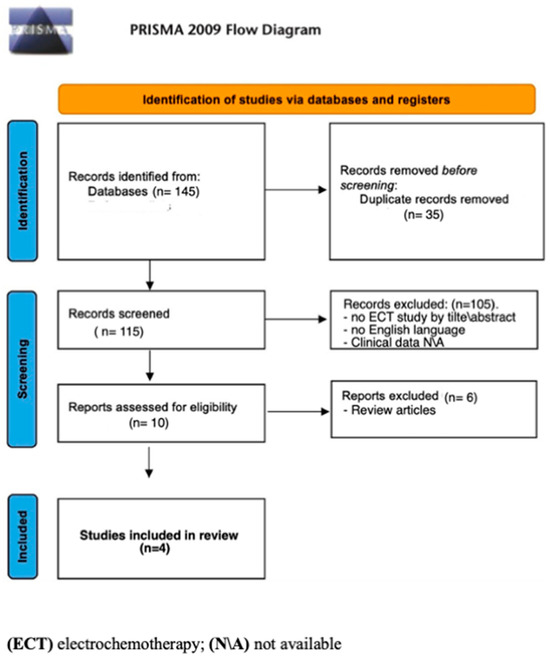
Figure 1
Open AccessArticle
Clinical Profile of Patients with Primary Sjögren’s Syndrome with Non-Identified Antinuclear Autoantibodies
by
Dorian Parisis, Julie Sarrand, Xavier Cabrol, Christine Delporte and Muhammad S. Soyfoo
Diagnostics 2024, 14(9), 935; https://doi.org/10.3390/diagnostics14090935 (registering DOI) - 30 Apr 2024
Abstract
Objectives—The aim of the present study was to characterize the clinical phenotype of patients with primary Sjögren’s syndrome (pSS) with non-identified antinuclear antibodies (ANA) in comparison with that of patients with pSS with negative ANA, positive typical ANA (anti-Ro/SSA and/or La/SSB) and positive
[...] Read more.
Objectives—The aim of the present study was to characterize the clinical phenotype of patients with primary Sjögren’s syndrome (pSS) with non-identified antinuclear antibodies (ANA) in comparison with that of patients with pSS with negative ANA, positive typical ANA (anti-Ro/SSA and/or La/SSB) and positive atypical ANA. Methods—We conducted an observational, retrospective monocentric study at the Erasme University Hospital (Brussels, Belgium). Two hundred and thirty-three patients fulfilling the 2002 American–European Consensus Group criteria for pSS were included in this study. The patients were subdivided according to their ANA profile and demographics. The clinical and biological data of each subgroup were compared. Moreover, the relationships between these data and the ANA profiles were determined by multiple correspondence analysis. Results—In our cohort, 42 patients (18%) presented a non-identified ANA-positive profile. No statistically significant difference could be observed between non-identified ANA patients and ANA-negative patients in terms of age and/or ESSDAI score at diagnosis. There were significantly more frequent articular manifestations, positive rheumatoid factor (RF), and the use of corticosteroids in anti-Ro/SSA-positive patients compared to ANA-negative (p ≤ 0.0001) and non-identified ANA-positive patients (p ≤ 0.01). However, a significantly higher proportion of RF positivity and corticosteroid treatment was observed in non-identified ANA-positive patients compared to ANA-negative patients (p < 0.05). Conclusions—For the first time to our knowledge, our study has characterized the clinical phenotype of patients with pSS with non-identified ANA at diagnosis. The non-identified ANA-positive patients featured mostly a clinical phenotype similar to that of the ANA-negative patients. On the other hand, the non-identified ANA-positive patients were mainly distinguished from the ANA-negative patients by a greater proportion of RF positivity and the need for corticosteroid use due to articular involvement.
Full article
(This article belongs to the Topic Rheumatic Disorder: From Basic Science to Clinical Practice)
►▼
Show Figures
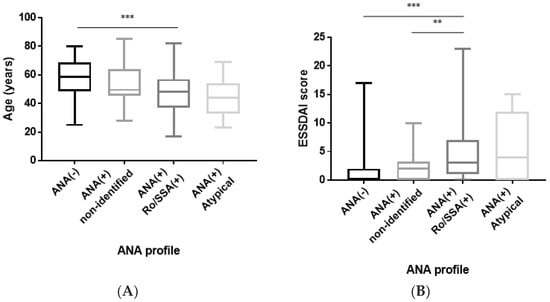
Figure 1

Journal Menu
► ▼ Journal Menu-
- Diagnostics Home
- Aims & Scope
- Editorial Board
- Reviewer Board
- Topical Advisory Panel
- Instructions for Authors
- Special Issues
- Topics
- Sections & Collections
- Article Processing Charge
- Indexing & Archiving
- Editor’s Choice Articles
- Most Cited & Viewed
- Journal Statistics
- Journal History
- Journal Awards
- Society Collaborations
- Conferences
- Editorial Office
Journal Browser
► ▼ Journal BrowserHighly Accessed Articles
Latest Books
E-Mail Alert
News
Topics
Topic in
Algorithms, Diagnostics, Entropy, Information, J. Imaging
Application of Machine Learning in Molecular Imaging
Topic Editors: Allegra Conti, Nicola Toschi, Marianna Inglese, Andrea Duggento, Matthew Grech-Sollars, Serena Monti, Giancarlo Sportelli, Pietro CarraDeadline: 31 May 2024
Topic in
Biomedicines, Current Oncology, Diagnostics, Gastrointestinal Disorders, JCM
Advances in Gastrointestinal and Liver Disease: From Physiological Mechanisms to Clinical Practice
Topic Editors: Davide Giuseppe Ribaldone, Gian Paolo CavigliaDeadline: 20 June 2024
Topic in
Biomolecules, Diagnostics, JCM, Metabolites, JPM, Nutrients
Metabolic Syndrome, Biomarkers and Lifestyles
Topic Editors: Sang Yeoup Lee, Young Hye ChoDeadline: 30 June 2024
Topic in
Cancers, Diagnostics, JCM, Current Oncology, Gastrointestinal Disorders, Biomedicines
Hepatobiliary and Pancreatic Diseases: Novel Strategies of Diagnosis and Treatments
Topic Editors: Alessandro Coppola, Damiano Caputo, Roberta Angelico, Domenech Asbun, Chiara MazzarelliDeadline: 20 July 2024

Conferences
Special Issues
Special Issue in
Diagnostics
Fifth Anniversary of "Machine Learning and Artificial Intelligence in Diagnostics" Section
Guest Editors: Dania Cioni, Salvatore Claudio FanniDeadline: 10 May 2024
Special Issue in
Diagnostics
Monitoring and Diagnosis of Patients during Rehabilitation Training
Guest Editor: Redha TaiarDeadline: 31 May 2024
Special Issue in
Diagnostics
Improvement of Diagnostic Sensitivity for Tumor Markers
Guest Editors: Jong-Han Lee, Jooyoung ChoDeadline: 16 June 2024
Special Issue in
Diagnostics
Endoscopy and Diagnostic Tools in Hepatobiliary and Pancreatic Diseases
Guest Editor: Stefano Francesco CrinòDeadline: 30 June 2024
Topical Collections
Topical Collection in
Diagnostics
Editorial Board Members' Collection Series: Diagnostic Approaches to Gastrointestinal and Pancreatic Diseases
Collection Editors: Paolo Aseni, Ervin Toth



